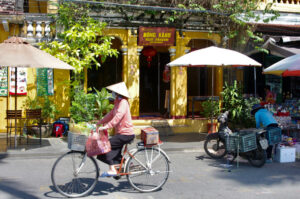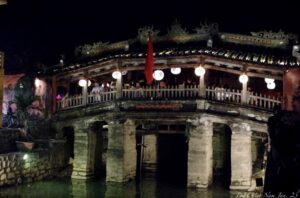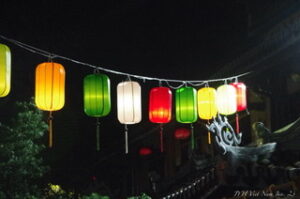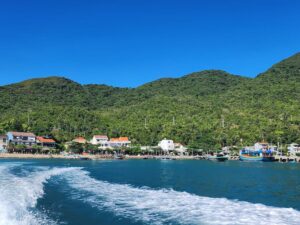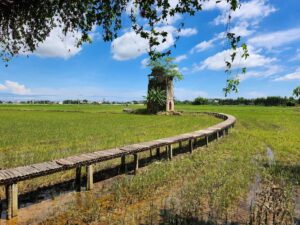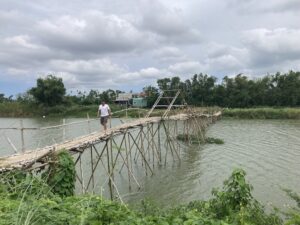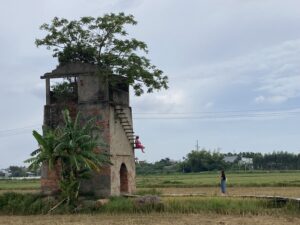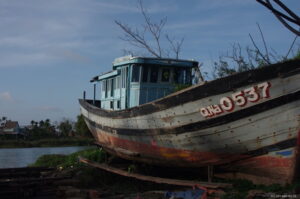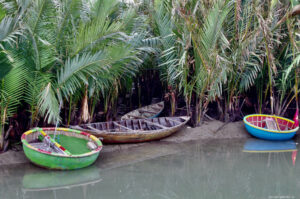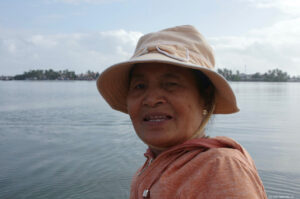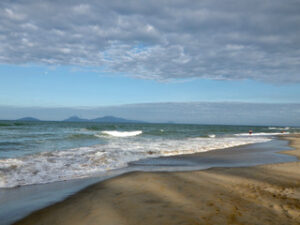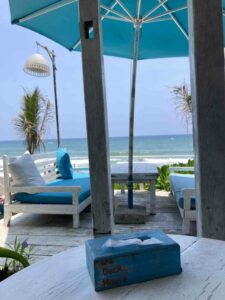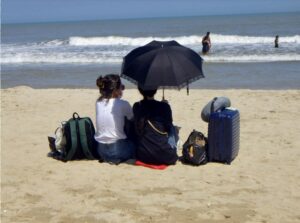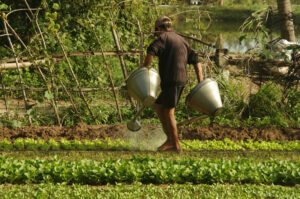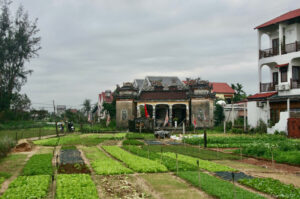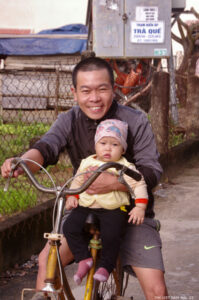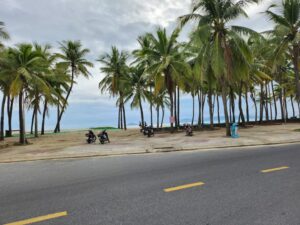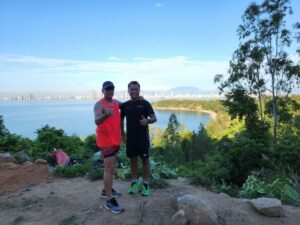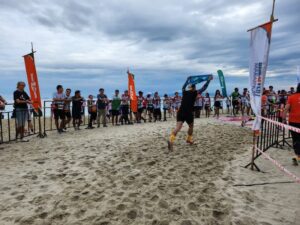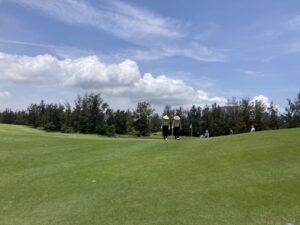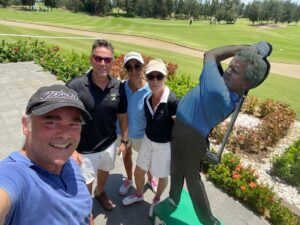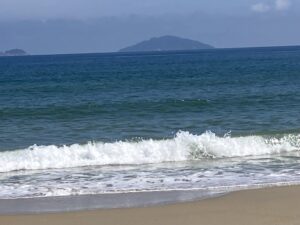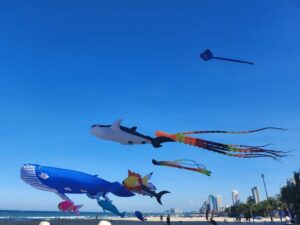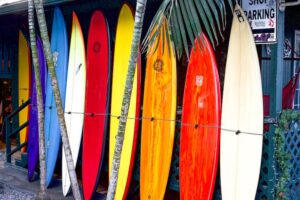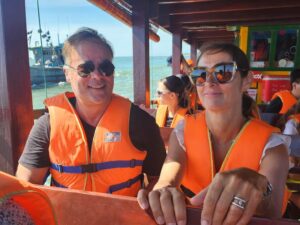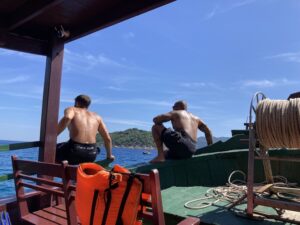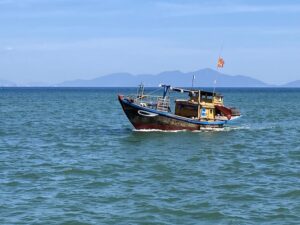A stay in Hoi An is like a freeze-frame on an adventurous journey. The clock stops ticking to reveal the charms and refinement of a centuries-old heritage to those who know how to look, listen and taste.
The art and history of a World Heritage jewel? Immersion in the kingdom of Champa? A road trip through ancestral farming practices? Dive between mangroves, rivers and the South China Sea? From rituals to corporate heritage, the reality of village life? Illuminated evenings, gourmet tables, markets and stalls galore?
Hoi An attracts, Hoi An overflows, but Hoi An slowly reveals itself…
La Maison organizes for you
THE OLD TOWN OF HOI AN
A former trading port of the Champa kingdom (2nd – 10th century), Hoi An is a historic town in Quang Nam province, in central Vietnam. Its charm stems from its splendid wooden architecture, which led to its classification as a UNESCO World Heritage Site in 1999. Nearly 800 buildings have been preserved and still belong to Vietnamese families, who live in them and maintain them with great care.
The result of successive migrations (16th-17th centuries), its Japanese and Chinese influences have given rise to a splendid Sino-Nipponese art, to which the bourgeois architecture of the French colonial period (1887-1954) has been added.
During the last war, Hoi An was miraculously spared by American bombing raids due to the natural silting up of its river, de facto pushing strategic interests back to Tourane (now Danang). As a result, the old buildings have preserved certain features rarely found elsewhere, from the wooden fences of the storefronts, the am (yin) and duong (yang) tiles of the roofs, to the protective mat cua (door eyes). In turn, they are meticulously restored in accordance with the strict rules of historic preservation institutions.
The Maison d’Indochine invites you to discover the city’s :
- A simple stroll, to take the pulse of its atmosphere and revel in the colors of early morning, the golds of late day and the lantern-lit nightlife of cafés and street vendors,
- A guided heritage tour of the most remarkable sites, from the communal houses of congregations(hoi quan) to places of worship (temples and pagodas) and the private homes of notables,
- An approach to the most beautiful bourgeois houses, magnificently restored to house restaurants or shops with fine brand names, including that of the Franco-Vietnamese weaver Metiseko,
- A visit to the museum of ethnological heritage, not forgetting the Precious Heritage gallery/museum, where ethnic groups are revealed through Réhahn’s lens,
A contemplation of the ochre cameos, from the weathered facades buried under the flowering foliage of Hoi An to the rice harvests of the surrounding countryside (by motorcycle).
THE CHAM CULTURE
Probably originating from Indonesia, the Chams settled on the coasts of central and southern Vietnam as early as the first millennium BC. It was trade that led to their original settlement in ports, opening up routes to China and India.
THE MY SON SITE
“For almost a millennium, the rulers of ancient Champa built their temples in the hollow of a natural cirque in Quang Nam province, not far from present-day Danang. The monuments, known today as My Son, were discovered in the 19th century by French colonial troops, then studied for the first time by specialists from the École Française d’Extrême Orient (EFEO). In 1999, UNESCO recognized the remains of the brick towers adorned with sculptures and engravings as part of humanity’s cultural heritage (…).
Since the research undertaken by French scholars in the early 20th century, My Son has been well known as the “holy land” of the ancient rulers of Champa. Recent, more detailed research on the site tends to the same conclusion – the concentration of such a quantity of religious monuments built in a small valley, the artistic quality of the decorations, the number of inscriptions engraved to express the devotion of kings, princes and pretenders, have led to the identification of My Son as a religious center, symbolic of royalty, where the national palladium, in the form of a Siva – lingua, was kept. Beyond its purely religious function, the site was also a place of royal memory, aimed at legitimizing the power of the dynasties that succeeded one another in Champa (Patrizia Zolese – Le champa et l’archéologie à My Son – Publication EFEO/ Ambassade de France et Coopération italienne au VN)”.
Successive invasions have left their mark on the site, which today boasts a dozen towers that are the focus of restoration programs (France, Italy, India), concentrated on certain groups of buildings.
La Maison’s advice – Early morning is best!
THE DANANG CHAM MUSEUM
Built between 1915 and 1919 by the EFEO, this museum houses the world’s finest collection of Cham art (over 300 pieces are on display, the rest being housed at the Guimet Museum in Paris). Drawn from the 4 corners of the former empire, the collection features sandstone sculptures dating from the 5th to the 15th centuries. A visit provides an insight into the art of Champa, which assimilates the Indian heritage of the Great Vehicle and draws its inspiration from Buddhism and Hinduism.
La Maison’s advice – Culture buffs will find it worthwhile to combine a visit to the My Son site with a visit to the Cham Museum, to gain a broader insight into the expression of the Champa kingdom.
THE CHAM ISLANDS
From the 4th to the 14th century, these islands were one of the largest ports in the Cham kingdom. From the 17th century onwards, they played a strategic role as a shelter and free trade zone for passing ships. Today, the archipelago’s 7 islets are protected as a natural site (tropical vegetation and seabed). Only two islands are inhabited, exclusively by fishermen, the others remaining untouched or under military aegis.
La Maison’s advice – A visit to the Cham islands (possible for a day on the main island) focuses more on underwater exploration (see La Maison’s sports page).
CYCLING IN THE COUNTRYSIDE
Vietnam is definitely the land of “two wheels”! From the ancestral bicycle to the latest motorcycle, via the electric bikes of a cheeky youth, the cycle is the means of locomotion that provides the most pleasure and freedom.
Immediately around La Maison, it’s the organic vegetable gardens and riverside activity of the village of Tra Quê that catch the eye: the agrarian and lakeside scenes are enchanting, up close to the livestock, pastures and crops. Further afield, as you wander through rice paddies and weaving rivers, you’ll come across relics of yesteryear: abandoned brick kilns, a shaky bamboo bridge still in use, colorful temples, traditional life where cycles, livestock and children’s games mingle in a joyous din under the watchful eye of the elders. Last but not least, as the handicrafts of Hoi An’s stalls are most often produced outside the city, it’s the weavers, leatherworkers, boat carpenters, sculptors, potters, mother-of-pearl inlayers and lantern makers you’ll meet along the way.
So fellow travelers, alone or in groups, with a La Maison partner or on your own, mount your steeds and immerse yourself in local life! The Hoi An countryside is full of poetry…
La Maison’s advice – La Maison d’Indochine shares its favourite itineraries with hidden stops…
MANGROVES AND THE VILLAGE OF CÂM THANH
A 15-minute cycle ride from La Maison, the mangrove swamp of Câm Thanh is a delight for nature-lovers. Populated by water coconut trees, which are farmed by the villagers, this mangrove has developed since its origins as a trading area with the Mekong delta. An expanse of tranquil waters with a fragile equilibrium, the mangrove seduces visitors to contemplate aquatic life amidst dragonflies, shellfish, wading birds and fishermen at the mouth of the river. From the canals of tropical vegetation where you slip through to the sea opening punctuated by carrelets and colorful boats, the fish-filled waters shimmer with silver as the shadows lengthen or dissipate…
Here, as elsewhere, Vietnam’s beautiful sites are being swallowed up by a tourist horde that surges relentlessly in a sound debauchery. The mangroves can only be explored at dawn or sunset, alone, with your sea legs and a good pair of binoculars!
La Maison’s advice – La Maison d’Indochine organizes a special outing for you with a village elder, in a basket boat.
THE BEACHES
With its turquoise waters and azure skies, the white sandy beach of An Bang is a picture postcard. Adorned with beautiful coconut palms, it offers bathers clear, temperate water, ideal for relaxing moments. Lined with bars and restaurants, An Bang welcomes you for a very pleasant day out, where you can indulge in the pleasures of beach games and water sports (attractive prices).
- Thrill-seekers can try their hand at jet-skiing, parasailing or surfing.
- Gourmets can try seafood, where grilled calamari, clams with lemongrass and shellfish rival traditional recipes.
- If you’re looking for peace and quiet, the restaurants provide deckchairs for a comfortable siesta.
As for lovers in search of tranquillity, Hà My beach remains authentic, with a few Vietnamese paillotes: La Maison sometimes takes refuge there under the coolness of an old-fashioned fan to enjoy a ceviche of mahi-mahi…
La Maison’s advice – Choose the early morning to swim and stroll in peace and quiet under the silver lights – Avoid the late afternoon when the Vietnamese flock to the beach to swim and dine.
THE VILLAGE OF TRA QUÊ AND ITS ORGANIC GARDENS
Situated on an islet of river in the middle of rice fields, the village of Tra Que is home to the vegetable garden of the city of Hoi An. Halfway between the listed city and An Bang beach, its reputation is based on the diversity of its aromatic herbs and its organic market-gardening techniques. Known as Nhu Que (meaning herbs/vegetables, scent of camellia) since the early 18th century, the village is said to have become Tra Que (Cinnamon, scent of camellia) when one of the Nguyen kings took a cruise on the De Vong river and was won over by a dish of vegetables with the subtle taste of cinnamon and the scent of camellia.
Contemplating the simple crops grown in these gardens, which are meticulously tended by an army of pointy hats, is a sight to behold. No fewer than 20 varieties of vegetables and aromatic herbs of exceptional quality, including basil, water mint and perilla, are grown over an area of 40 hectares. The surrounding area is dominated by rice-growing and peneiculture, the rituals of which punctuate the work of the villagers, with the passing of peaches, harvests and moons.
In the heart of this charming village, La Maison d’Indochine helps to promote a protected heritage to travellers who love the environment and healthy eating.
La Maison’s advice – Pascale and Olivier will take you on their daily stroll, enhanced by selected stops, as close as possible to the locals.
SPORT AT LA MAISON D’INDOCHINE
It’s almost a pleonasm to associate physical culture with La Maison d’Indochine… As Olivier enjoys every sport on earth, it’s very rare that he doesn’t take you on a run through the rice paddies, a round of golf or some nautical pleasures!
RUNNING
The paths and small roads that criss-cross the surrounding countryside form an ideal network for runners, whether you’re looking to maintain your fitness levels or do more ambitious training in preparation for an event. With a detailed map of the area and the relevant applications, you can enjoy the beautiful countryside and a few hidden rest stops.
La Maison’s tip – Ask Olivier for his favourite routes
GOLF
The area between Danang and Hoi An boasts a generous golfing offer, both in terms of the diversity of its natural settings and its VIP services. There are six magnificent courses between the sea and the mountains, with very comfortable infrastructures and conditions. Just a stone’s throw from La Maison d’Indochine, the Montgomerie Links Vietnam – Golf Club is a very pleasant place to play, particularly in spring (between February and June).
La Maison’s advice – La Maison will take care of organising your day (transfers, course and/or equipment bookings).
SURFING
The best time of year for surfing is between November and March, during the winter monsoon season. Typhoons develop at this time, producing strong swells in warm water for most of the year.
Danang Bay (30 minutes away) is a great spot. The beaches of Hoi An (An Bang and Cua Dai) offer a picturesque seafront with a 3km stretch of white sand. The water is clear and the blue waves are great for surfing.
La Maison’s advice – La Maison recommends the Go Surfing shop for board rental and waxing.
DIVING IN THE CHAM ISLANDS
Off the coast of Vietnam, the Cham Islands are one of the rare sites offering diversity to divers. The coral reefs are interesting and shelter a rich fauna. The Dragon Reef is undoubtedly one of the most beautiful dive sites on the coast.
Although there is a steady stream of boats landing tourists for the day, a sea trip with Cham Diving Island :
- A colourful boat with a slow rhythm, intoxicated by the landscapes and summer lights where blue and green meet,
- An efficient, professional team, attentive to both the novice and the enlightened amateur,
- The conviviality of a meal on the beach, in an unspoilt natural setting
La Maison’s advice – Whether you’re a beginner or an expert, La Maison d’Indochine can book your outing with our partner.

